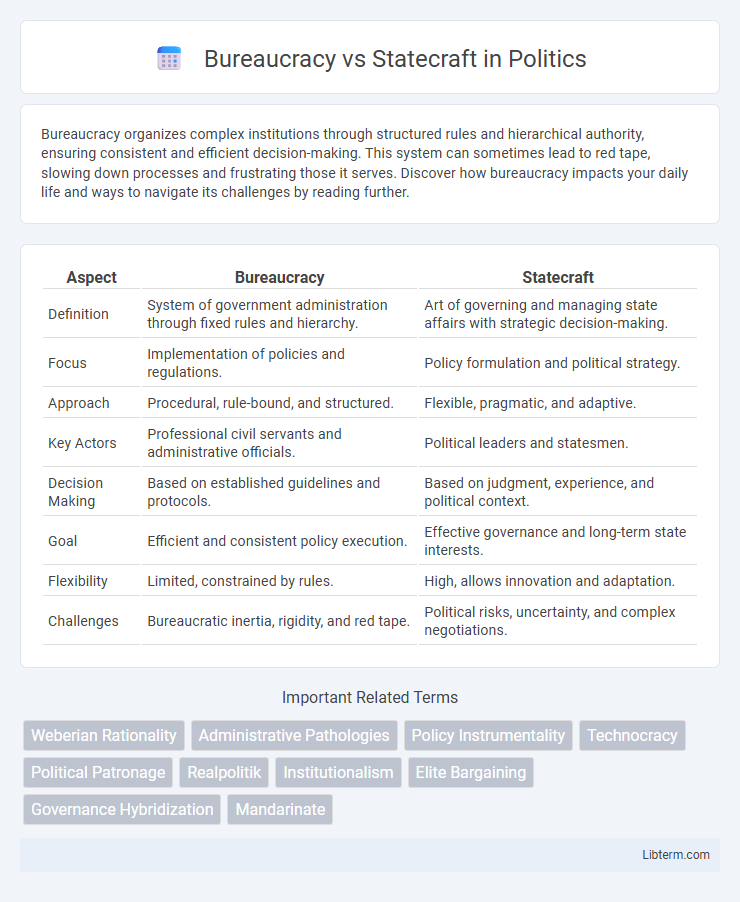Bureaucracy organizes complex institutions through structured rules and hierarchical authority, ensuring consistent and efficient decision-making. This system can sometimes lead to red tape, slowing down processes and frustrating those it serves. Discover how bureaucracy impacts your daily life and ways to navigate its challenges by reading further.
Table of Comparison
| Aspect | Bureaucracy | Statecraft |
|---|---|---|
| Definition | System of government administration through fixed rules and hierarchy. | Art of governing and managing state affairs with strategic decision-making. |
| Focus | Implementation of policies and regulations. | Policy formulation and political strategy. |
| Approach | Procedural, rule-bound, and structured. | Flexible, pragmatic, and adaptive. |
| Key Actors | Professional civil servants and administrative officials. | Political leaders and statesmen. |
| Decision Making | Based on established guidelines and protocols. | Based on judgment, experience, and political context. |
| Goal | Efficient and consistent policy execution. | Effective governance and long-term state interests. |
| Flexibility | Limited, constrained by rules. | High, allows innovation and adaptation. |
| Challenges | Bureaucratic inertia, rigidity, and red tape. | Political risks, uncertainty, and complex negotiations. |
Defining Bureaucracy: Structure and Function
Bureaucracy is defined by its hierarchical structure, standardized procedures, and specialized roles designed to efficiently implement policies and maintain organizational order within government institutions. Its core function involves the execution of laws and regulations through formal rules and processes, ensuring consistency and predictability in public administration. This systematic framework contrasts with statecraft, which emphasizes political strategy and leadership in shaping national policy and diplomatic relations.
Understanding Statecraft: Strategy and Leadership
Statecraft involves strategic decision-making and effective leadership to navigate political complexities and achieve national goals. Unlike bureaucracy, which emphasizes rules and procedures, statecraft prioritizes adaptable strategies and visionary leadership to manage resources and influence both domestic and international arenas. Successful statecraft integrates intelligence, diplomacy, and military strategy to maintain sovereignty and promote long-term stability.
Historical Perspectives: Bureaucracy and Statecraft in Governance
Historical perspectives reveal that bureaucracy has long served as the administrative backbone of governance, emphasizing standardized procedures and hierarchical control. Statecraft, by contrast, encompasses the strategic and diplomatic skills wielded by leaders to navigate complex political landscapes and shape national policy. The interplay between bureaucracy's structural efficiency and statecraft's adaptive decision-making has been crucial in the evolution of effective governments throughout history.
Key Differences: Bureaucratic Processes vs. Strategic Decision-Making
Bureaucratic processes emphasize standardized rules, hierarchical administration, and procedural compliance to maintain order and consistency within organizations, often resulting in slower decision-making. In contrast, statecraft prioritizes strategic decision-making, leveraging political acumen, long-term vision, and flexible tactics to navigate complex power dynamics and achieve national objectives. The key difference lies in bureaucracy's focus on process and stability versus statecraft's emphasis on adaptability and strategic outcomes.
Bureaucratic Efficiency vs. Statecraft Innovation
Bureaucratic efficiency emphasizes standardized procedures, consistent rule enforcement, and predictable administrative processes to ensure stable governance and resource management. Statecraft innovation prioritizes adaptive strategies, creative policymaking, and dynamic leadership to navigate complex political landscapes and foster long-term national interests. Balancing bureaucratic rigidity with statecraft flexibility is crucial for effective governance and sustainable development.
Case Studies: Success and Failure in Bureaucracy and Statecraft
Case studies in bureaucracy and statecraft reveal contrasting outcomes shaped by administrative efficiency and political strategy. Successful statecraft often hinges on adaptive bureaucracy that implements policies effectively, as seen in Singapore's streamlined civil service fostering economic growth. Conversely, failures emerge when rigid bureaucracy stifles innovation and responsiveness, illustrated by the inefficiencies during the Soviet Union's centralized planning, leading to systemic collapse.
The Role of Bureaucrats in Modern Statecraft
Bureaucrats serve as the operational backbone of modern statecraft, implementing policies and ensuring continuity within government functions. Their expertise in navigating regulatory frameworks and administrative procedures enables effective governance and policy execution. The efficiency and adaptability of bureaucracies directly impact state capacity, public trust, and the overall success of political leadership.
Challenges of Balancing Bureaucracy and Statecraft
Balancing bureaucracy and statecraft presents significant challenges in maintaining efficient governance while ensuring strategic, long-term policy implementation. Bureaucratic structures often emphasize rigid procedures and risk aversion, which can stifle innovation and slow decision-making crucial for effective statecraft. Achieving synergy requires adaptive leadership that harmonizes procedural compliance with flexible, visionary strategies to respond dynamically to complex political and social environments.
Reforming Governance: Integrating Bureaucratic and Statecraft Approaches
Reforming governance requires blending bureaucratic efficiency with strategic statecraft to achieve adaptive and responsive institutions. Bureaucratic structures provide procedural consistency and accountability, while statecraft emphasizes political acumen and flexible decision-making to address complex challenges. Integrating these approaches enhances policy implementation, promotes innovation, and ensures governance aligns with dynamic socio-political contexts.
Future Trends: Evolving Dynamics of Bureaucracy and Statecraft
Future trends in bureaucracy and statecraft highlight increasing reliance on digital governance tools and artificial intelligence to streamline administrative processes and enhance decision-making capabilities. The convergence of data analytics with traditional diplomatic strategies allows states to respond more swiftly to global challenges such as cybersecurity threats and climate change. Adaptive governance models that integrate human expertise with technological innovations are expected to reshape the effectiveness and transparency of statecraft in the coming decades.
Bureaucracy Infographic

 libterm.com
libterm.com